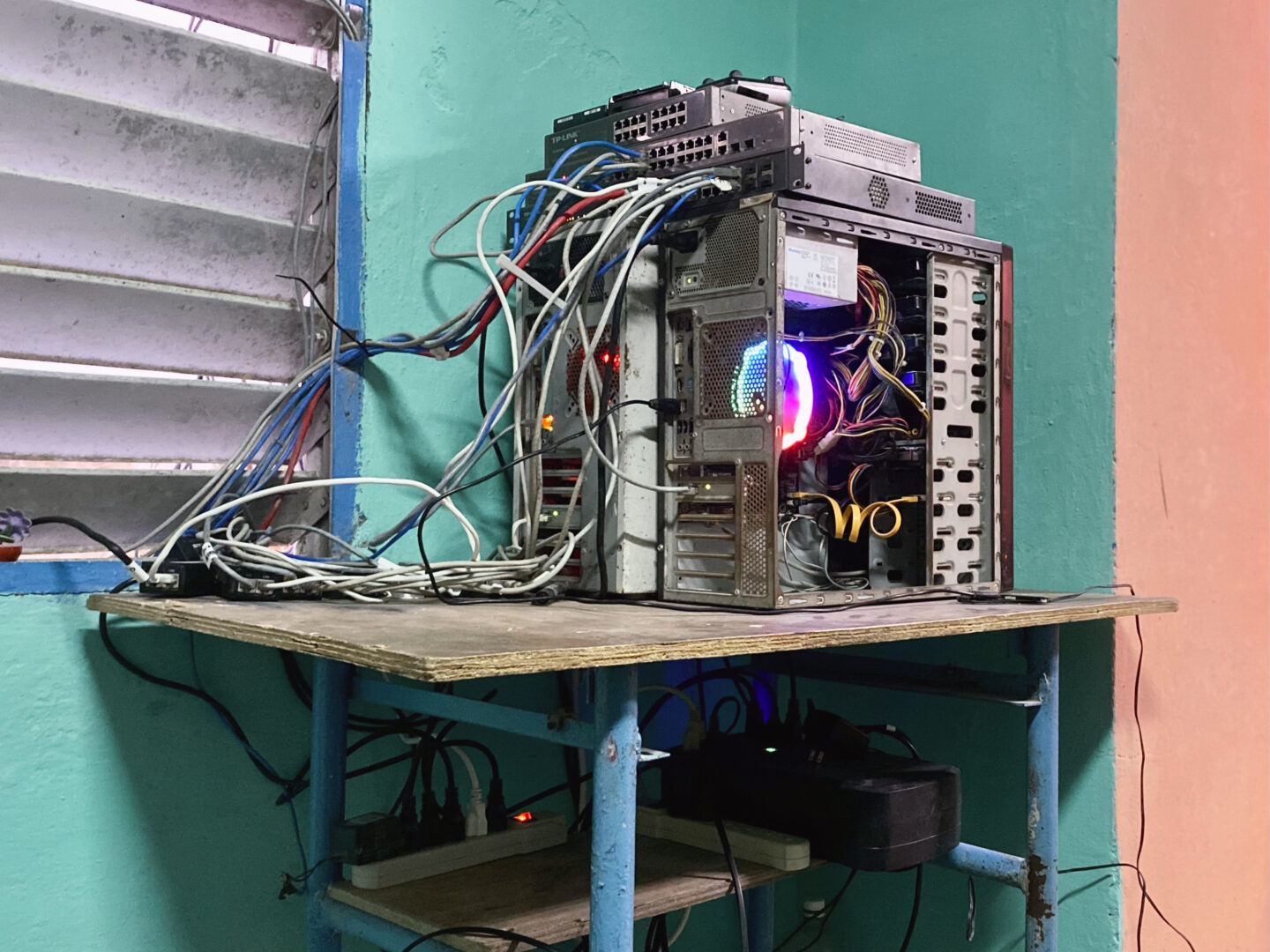2022 version commissioned by the Biennale Warszawa.
Fragile Connections is an artistic research project conducted by Nestor Siré and Steffen Köhn about SNET (Street Network), a vast grassroots computer network connecting tens of thousands of users across Cuba’s capital Havana. This vernacular infrastructure not only compensates for the lack of internet access but has also generates new relations between people and fostered new forms of community. SNET allows users to play multiplayer video games, chat, send messages, debate in forums, share files, or host websites. It relies on a network of thousands of participants who collaboratively create, operate, and maintain its hardware and software infrastructure, making it a unique local alternative to the global internet. The network’s material base consists of miles of ethernet cable running across streets or balconies, Wi-Fi antennas mounted on poles on rooftops, and servers and network switches operated by an army of volunteer node administrators. As the software interface through which the network is accessed, SNET makers have repurposed TeamSpeak, a voice conferencing software that allows users to communicate with each other via voice and text over the Internet or a local area network (LAN). While TeamSpeak is firmly rooted in gaming culture (being designed for gamers who can use the software to communicate with other players in the same team in a multiplayer video game), it is employed in SNET as a central organization tool for its many features, customizability, and low system requirements.
Based on this research, we created a series of projects that explore the particular digital practices, social dynamics, and human infrastructures within SNET. The exhibition consists of various elements: an interactive installation that replicates the technological set-up of an SNET node and thus constitutes a fully functioning local area network (SNET actually developed out of private LAN parties in which Cuban video gamers first experimented with network technology). This LAN not only hosts the three most popular SNET games but also runs a TeamSpeak server in which segments of interviews we conducted with SNET members are arranged as a real-time VoIP conversation across the three levels of its hierarchical structure: users, support, and administration. Audiences can connect to this network via their WIFI enabled devices and thus create user IDs and interact with each other in public TeamSpeak channels, creating a temporary offline community, which will remain as a documentation of the exhibition. The exhibition further presents a series of photographs, videos, and objects that represent the network’s distinctive infrastructure and the creative modifications users engage in, as well as an infographic that details the power dynamics and hierarchies within the network (conceived in collaboration with Cuban sociologist Adrián Olivares and designer Mauricio Vega). A set of stickers with icons and symbols SNET members use to create their digital identities allows visitors to performatively take on an SNET personality themselves.
Steffen Köhn is a filmmaker, anthropologist and video artist, based in Berlin, who uses ethnography to understand contemporary sociotechnical landscapes. For his video and installation works he engages in local collaborations with gig workers, software developers, or science fiction writers to explore viable alternatives to current distributions of technological access and arrangements of power. His works have been shown at the Academy of the Arts Berlin, Kunsthaus Graz, Vienna Art Week, Hong Gah Museum Taipei, Lulea Biennial, The Photographers’ Gallery and the ethnographic museums of Copenhagen and Dresden. His films have been screened at the Berlinale, Rotterdam International Film Festival, and the Word Film Festival Montreal, among others.
Nestor Siré is an artist based in Havana, Cuba. Siré’s artistic practice intervenes directly in social contexts in order to analyze specific cultural phenomena. His artistic methodology consists in engaging with existing social structures in order to explore new ways in which art can impact the complex relationships between official and informal networks. Often engaging with the particular idiosyncrasies of digital culture in the Cuban context, he works within the vernacular infrastructures his fellow citizens use for the distribution of media, information and goods. His works have been shown in the Museo Nacional de Bellas Artes (Havana), Queens Museum (New York), Rhizome (New York), New Museum (New York), Hong-Gah Museum (Taipei), Museo de Arte Contemporáneo (Mexico City), Museo de Arte Contemporáneo, Santa Fe (Argentina), The Photographers’ Gallery (London), among other places. He has participated in events such as the Manifesta 13 Biennial (France), Gwangju Biennale (South Korea), Curitiba Biennial (Brazil), the Havana Biennial (Cuba) and the Asunción International Biennale (Paraguay), the Festival of New Latin American Cinema in Cuba, and the Oberhausen International Festival of Short Film (Germany).
